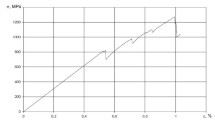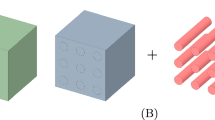Abstract
Wide application of polymer composite materials (PCM) in modern technology calls for detailed evaluation of their stress-strain properties in a broad temperature range. To obtain such information, we use the dynamic mechanical analysis and with the help of a reverse torsion pendulum measure the dynamic torsional rigidity of PCM bars of rectangular cross section in the temperature range up to 600 K. It is found that the temperature dependences of the dynamic rigidity of the calculated values of dynamic shear moduli are governed by the percentage and properties of the binder and fibers, the layout of fibers, the phase interaction along interfaces, etc. The principles of dynamic mechanical spectrometry are used to substantiate and analyze the parameters of anisotropy by which the behavior of a composite can be described in the temperature range including the transition of the binder from the glassy into a highly elastic state. For this purpose, the values of dynamic rigidity are measured under low-amplitude vibrations of the PCM specimens with a fiber orientation angle from 0 to 90°. It is shown that for unidirectional composites the dependence between the dynamic rigidity and the fiber orientation angle is of extreme character. The value and position of the peak depend on the type of the binder and fibers and change with temperature. It is found that the anisotropy degree of PCM is dictated by the molecular mobility and significantly changes in the temperature range of transition of the binder and reinforcement from the glassy into a highly elastic state (in the case of SVM fibers). The possibility of evaluating the anisotropy of composites with other reinforcement schemes, in particular, of orthogonally reinforced PCMs, is shown.
Similar content being viewed by others
References
E. K. Ashkenazi and E. V. Ganov, Anisotropy of Structural Materials. Handbook [in Russian], Leningrad (1980).
S. G. Lekhnitskii, Theory of Elasticity of Anisotropic Bodies [in Russian], Nauka, Moscow (1977).
A. K. Malmeister, V. P. Tamuzh, and G. A. Teters, Strength of Rigid Polymer Materials [in Russian], Riga (1972).
I. I. Perepechko, Acoustic Methods of Investigation of Polymers [in Russian], Moscow (1973).
O. V. Startsev, Yu. M. Vapirov, V. V. Sukhanov, and E. D. Makaradze, “A method of measuring the parameters of damped vibrations of a harmonic oscillator,” Auth. Certif. USSR No. 1359685, 1987.
S. G. Lekhnitskii, Torosion of Anisotropic and Inhomogeneous Bars [in Russian], Moscow (1971).
Yu. M. Tarnopol'skii and T. Ya. Kintsis, Methods of Static Tests of Reinforced Plastics [in Russian], Moscow (1981).
V. S. Ekel'chik, V. M. Ryabov, and B. A. Yartsev, “Coupled flexural-torsional vibrations of anisotropic bars of polymer composites. 1. Theoretical analysis of the effect of the anisotropy parameters of the material and the geometry of the bar on natural frequencies,” Mech. Compos Mater.,27, No. 6, 643–648 (1991).
A. A. Kovalenko, A. D. Nasonov, and O. V. Startsev, “Features of anisotropy of mechanical properties of polymer composite materials,” in: Int. Conf. “All-Siberian Readings on Mathematics and Mechanics.” Vol. 2. Mechanics, Tomsk (1997), p. 205.
V. S. Ekel'chik, A. A. Perren, V. M. Ryabov, and B. A. Yartsev, “Coupled flexural-torsional vibrations of anisotropic rods of polymer composites. 2. Comparison of calculated and experimental data for a rod of a carbon-fiber-reinforced plastic,” Mech. Compos. Mater.,28, No. 2, 163–168 (1992).
V. V. Isupov and O. V. Startsev, “Numerical methods in dynamic mechanical spectroscopy of polymers,” Int. Conf. “Mathematical Models and Numerical Methods of Continuum Mechanics,” 27 May–2 June, Novosibirsk (1996), pp. 292–293.
G. M. Bartenev, Structure and Relaxation Properties of Elastomers [in Russian], Khimiya, Moscow (1979).
O. V. Startsev, V. P. Meletov, B. V. Petrov, and G. P. Mashinskaya, “Study of the mechanism of aging of organotextolite in a subtropical climate,” Mech. Compos. Mater.,22, No. 3, 331–336 (1986).
O. V. Startsev, “Investigation of the effect of carbon filler on the molecular mobility and structure of polyamide-12,” Vysokomol. Soed.,25A, No. 11, 2267–2273 (1983).
Author information
Authors and Affiliations
Additional information
Translated from Mekhanika Kompozitnykh Materialov, Vol. 35, No. 3, pp. 291–308, May–June, 1999.
Rights and permissions
About this article
Cite this article
Startsev, O.V., Kovalenko, A.A. & Nasonov, A.D. Anisotropy of torsional rigidity of sheet polymer composite materials. Mech Compos Mater 35, 201–212 (1999). https://doi.org/10.1007/BF02257250
Received:
Revised:
Issue Date:
DOI: https://doi.org/10.1007/BF02257250




